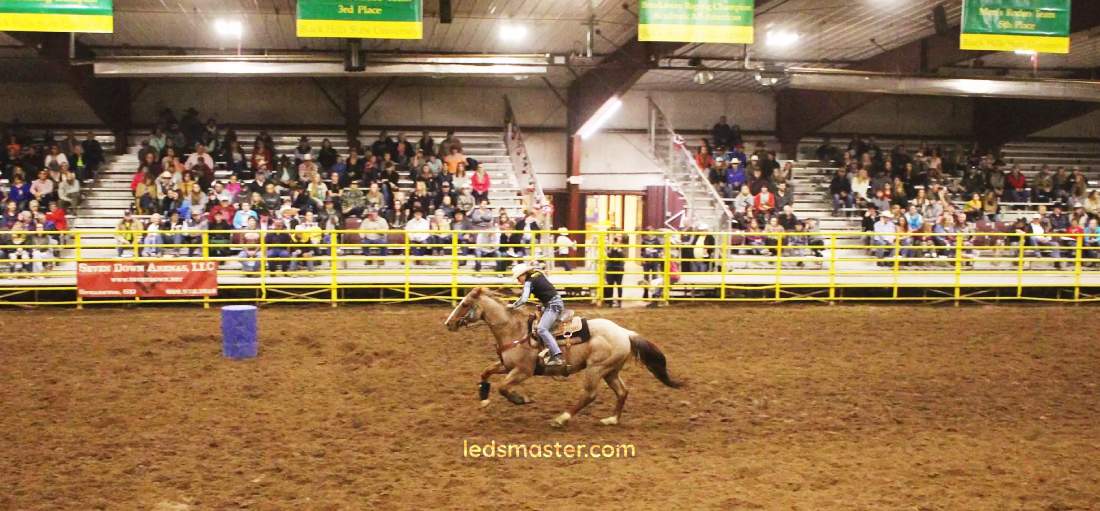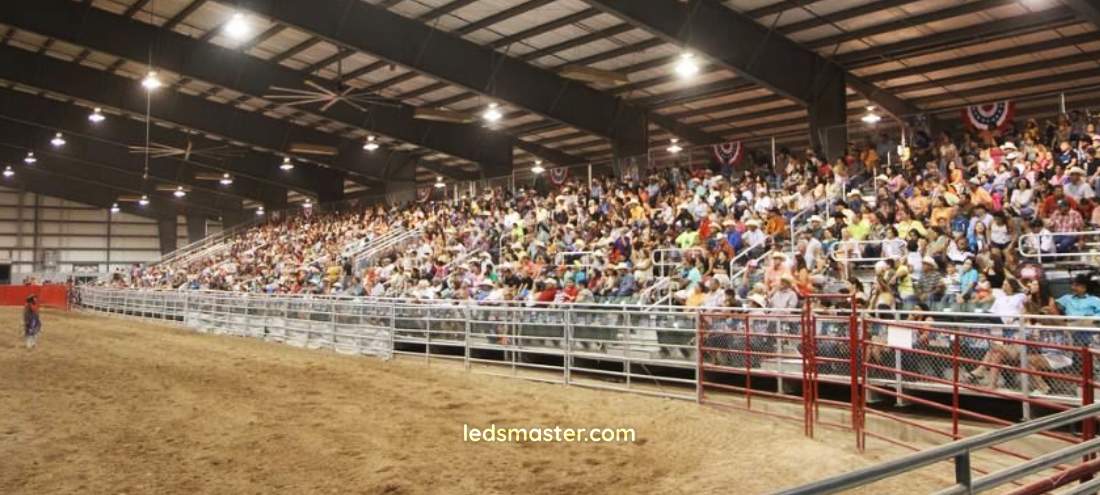Illuminate your rodeo arena with our premium Rodeo Arena Lighting, designed to meet the unique demands of rodeo events. Our lighting solutions ensure optimal visibility, safety, and performance, enhancing the experience for both participants and spectators.
Rodeo arenas are vibrant, dynamic spaces where thrilling events unfold under the watchful eyes of enthusiastic spectators. To ensure the safety of participants and the enjoyment of the audience, proper lighting is crucial. Effective rodeo arena lighting involves a blend of brightness, uniformity, color temperature, and other key factors. This article delves into the essential aspects of rodeo arena lighting and provides guidance on selecting the best lighting solutions for your arena.
Get your complimentary lighting design today
Table of Contents
ToggleBrightness is a fundamental aspect of arena lighting. For rodeo events, the lighting must be sufficiently bright to ensure clear visibility for participants, judges, and spectators. The recommended brightness levels, measured in lux (lx), for different areas of the arena are as follows:
| Area | Lux Required |
| Competition Area | 500 – 1000 lux |
| Spectator Areas | 200 – 300 lux |
| Perimeter and Walkways | 100 – 150 lux |
These levels ensure that the action is well-lit, while also providing comfortable lighting for spectators and safe passage for everyone in the arena.
Uniformity of light is another critical factor. Uneven lighting can create shadows and glare, which can be distracting and potentially dangerous for participants. A uniformity ratio of 0.5 to 0.7 is ideal for rodeo arenas. This ratio indicates that the lighting intensity should not drop below 50-70% of the average illuminance across the arena. Achieving uniform lighting requires careful planning and positioning of the light fixtures to avoid dark spots and overly bright areas.
Color temperature, measured in Kelvins (K), affects the appearance of the light. For rodeo arenas, a color temperature of 4000K to 5000K is recommended. This range provides a bright, neutral white light that enhances visibility and color perception without causing eye strain. A higher color temperature can create a cooler, more clinical atmosphere, while a lower temperature may result in a warmer, more yellowish light, which is less ideal for sporting events.

Choosing the right lighting fixtures for your rodeo arena involves considering several technical specifications to ensure optimal performance and efficiency. Here are the key factors to consider:
Lumens per watt (Lm/W) is a measure of the efficiency of a light source. It indicates how much light (lumens) is produced for each watt of electricity consumed. For rodeo arenas, it is crucial to select lights with high lumen output and high efficiency. Modern LED lights typically offer around 100-150 Lm/W, making them an excellent choice for energy savings and high brightness.
The beam angle of a light fixture determines how the light is distributed. In a rodeo arena, it is important to use a combination of wide and narrow beam angles to achieve uniform coverage. Wide beam angles (60-120 degrees) are suitable for general lighting, covering large areas with even light. Narrow beam angles (15-45 degrees) are ideal for highlighting specific areas, such as the competition zone or key spectator sections.
The weight of the lighting fixtures can impact the ease of installation and the structural requirements of the mounting points. Lighter fixtures are easier to install and put less strain on the support structures. It is essential to choose lights that are lightweight yet durable, ensuring they can withstand the outdoor elements and potential impacts. Additionally, consider the mounting options available, such as poles, brackets, or wall mounts, to ensure flexibility in positioning the lights for optimal coverage.
Rodeo arenas are typically outdoor venues, subjecting the lighting fixtures to various weather conditions. Therefore, it is vital to select lights with high durability and weather resistance. Look for fixtures with an IP65 or higher rating, indicating they are dust-tight and protected against water jets. This ensures the lights can withstand rain, dust, and other environmental factors without compromising performance.

The placement of the lights plays a crucial role in achieving the desired brightness and uniformity. Lights should be strategically positioned to cover the entire arena evenly. Consider using a combination of overhead lights and angled fixtures to minimize shadows and glare. Ensure that the lights are mounted at a sufficient height to provide broad coverage without creating harsh shadows or blind spots.
Regular maintenance is essential to keep the lighting system in optimal condition. Inspect the fixtures periodically for any signs of damage, such as cracked lenses or corroded components. Clean the lights regularly to remove dirt and debris that can reduce their efficiency. Additionally, replace any faulty or dimming lights promptly to maintain consistent brightness and uniformity.
Modern LED lighting offers several advantages over traditional lighting options, making it the preferred choice for rodeo arenas. These benefits include energy efficiency, longevity, instant on/off capabilities, dimmability, and low heat emission.
One of the most significant advantages of LED lighting is its superior energy efficiency. LEDs consume significantly less energy compared to incandescent or fluorescent lights. This reduction in energy consumption translates to lower electricity bills, which can be a substantial cost-saving measure for rodeo arenas, where lights are often used for extended periods. Moreover, the reduced energy usage contributes to a lower environmental impact, aligning with sustainability goals and reducing the carbon footprint of the arena. This efficiency makes LEDs an eco-friendly choice that supports long-term economic and environmental benefits.
LED lights have a remarkably long lifespan, often lasting 100,000 hours or more. This longevity far surpasses that of traditional lighting options, such as incandescent or fluorescent bulbs, which typically last only a fraction of this time. The extended lifespan of LED lights means that the frequency of replacements and maintenance is significantly reduced. This not only lowers the overall maintenance costs but also minimizes disruptions caused by the need to frequently replace lights. For rodeo arenas, where consistent and reliable lighting is crucial, the durability and long life of LEDs ensure a dependable lighting solution that requires minimal intervention.
Unlike some traditional lighting options that require a warm-up period before reaching full brightness, LED lights provide instant illumination. This immediate on/off capability ensures that the arena can be lit up instantly when needed, which is particularly important for events that may start or continue into the evening. The instant brightness of LEDs enhances safety by ensuring that there is no delay in achieving optimal visibility. This feature is also advantageous during power outages or when quick adjustments to lighting levels are required, providing a seamless experience for both participants and spectators.
LED lights offer excellent dimmability, allowing for easy adjustment of brightness levels to suit different event requirements. This flexibility in lighting control enables arena operators to create the perfect lighting conditions for various activities, from intense rodeo competitions to more subdued events or practices. The ability to dim lights can also contribute to energy savings, as lights can be set to lower levels when full brightness is not necessary. This adaptability ensures that the lighting can be precisely tailored to enhance the atmosphere and visibility, providing an optimal experience for all attendees.
LEDs generate minimal heat compared to traditional lighting sources. This low heat emission reduces the risk of overheating and creates a safer environment for both participants and spectators. In a rodeo arena, where physical activity and large crowds can raise temperatures, the reduced heat output of LED lights helps maintain a more comfortable ambient temperature. Additionally, the lower heat generation means that LED fixtures have a reduced risk of causing fire hazards, enhancing the overall safety of the venue. This characteristic also contributes to the longevity of the fixtures, as they are less likely to suffer from heat-related damage.
By understanding the key lighting design principles and selecting the best lighting fixtures based on factors such as lumens per watt, beam angle, weight, and durability, you can create a well-lit, vibrant arena that enhances the overall rodeo experience. Modern LED lighting solutions offer unparalleled efficiency, longevity, and versatility, making them the ideal choice for any rodeo arena. Invest in high-quality lighting to illuminate your rodeo events with brilliance and clarity, ensuring a memorable experience for all.